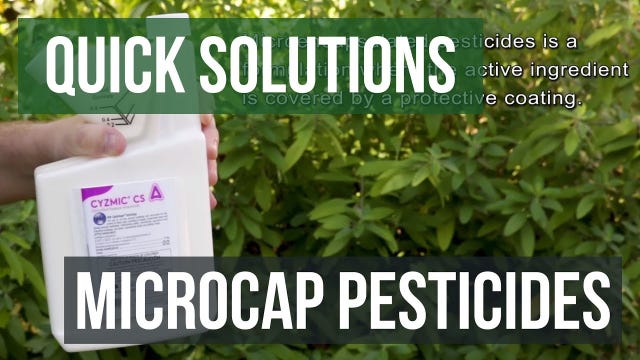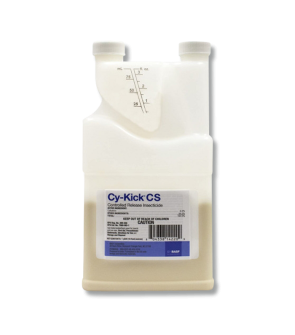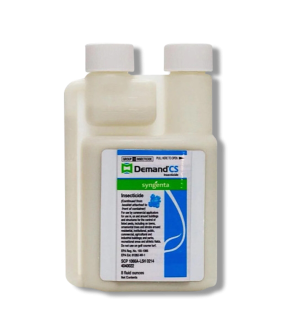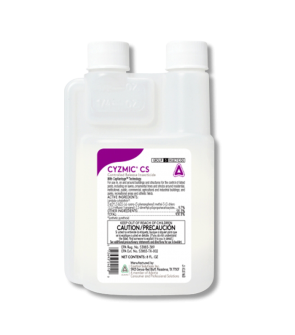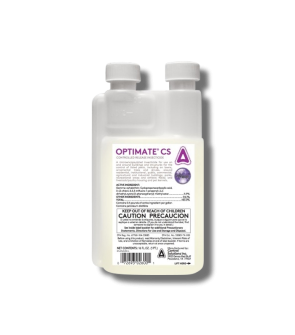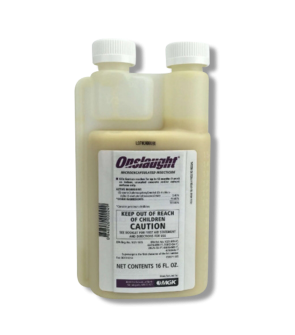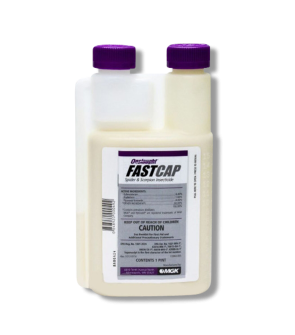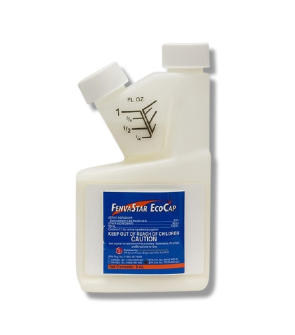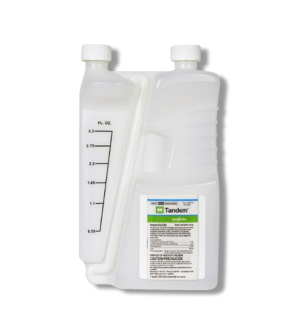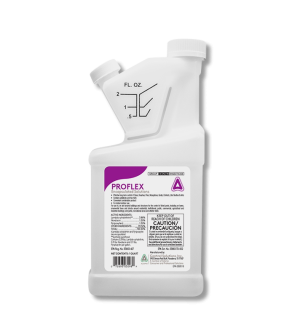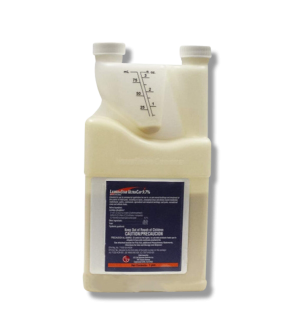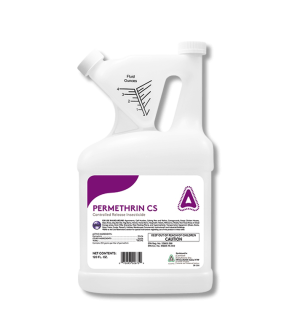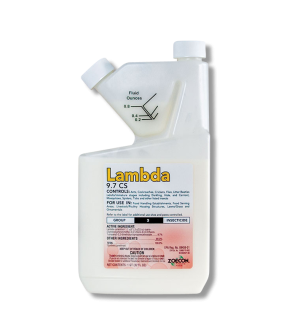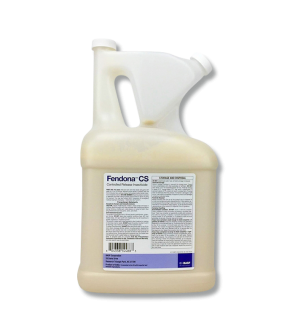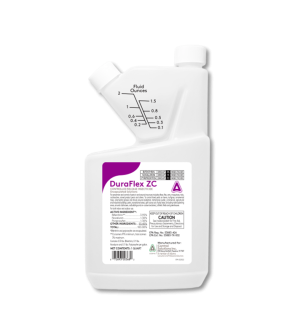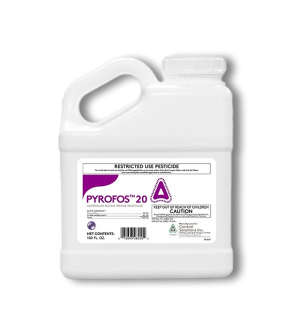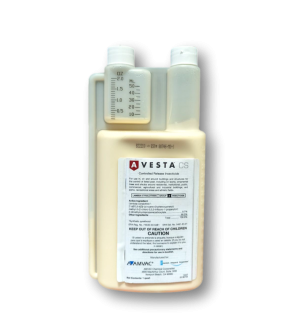Gain access to personalized product screening, the best pricing, rewards, and more!
Microencapsulated Pesticides (CS)
Microencapsulated pesticide formulations have been rapidly increasing in popularity over the years and for a good reason. Pest control professionals love the excellent knockdown microencapsulated products delivered to pests. Not only are these insecticides effective, but they are also safer for the environment compared to older chemicals designed for pest control.
At Solutions Pest & Lawn, we carry a wide selection of microencapsulated professional-grade insecticides. On this page, we will briefly explain microencapsulated insecticides, why they are so beneficial, and how to properly apply them for successful pest control around your home.
What is a Microencapsulated Insecticide?
Microencapsulated pesticides are insecticides where the pesticide's active ingredient (whether dry or liquid) is covered (or encapsulated) by a protective coating (polymer). The coatings may be plastic, starch, or some other type of material. Microencapsulated pesticides are mixed with water and applied as a spray, like any other sprayable pesticide formulation.
After spraying, the plastic coating of the microencapsulated pesticide breaks down and releases the active ingredient inside the capsule. In some situations, encapsulation can provide a “timed” slow release of the active ingredient.
Depending on the physical makeup of the coating, the release of the pesticide's active ingredient may depend upon the environment's weather. If the release is slower than usual (for reasons such as dry or cool weather), residues may remain on treated plants or surfaces longer than expected.
Other factors that can be altered depending on the chemistry of the polymer or changing factors in the processing are the residual effect of the insecticide, the speed of action, odor, and safety of the product.
The microcapsules are suspended in the liquid base of the formulation so that the final formulation is a flowable suspension. The formulation is mixed with water and requires regular agitation to prevent the capsule from settling.
Conditions for Using Microencapsulated Pesticides
Microencapsulated pesticide formulations are great for general indoor and outdoor pest control because they have a long residual effect and can quickly knock down several different pests.
Microencapsulated insecticides can treat pests in agricultural, ornamental, turf, forestry, structural (residential and commercial) food processing, livestock, and public health settings. They are also versatile in the kinds of equipment they can be applied in—from small, portable sprayers to hydraulic sprayers, low-volume ground sprayers, mist blowers, and low-volume aircraft sprayers.
There are several reasons you may choose a microencapsulated liquid insecticide. We recommend using them for general pest control for insects found around your household. One particular use of applying microencapsulated insecticides is setting up a pesticide barrier around the perimeter of your home or building.
Some microencapsulated pesticide products contain highly toxic materials coated to increase handler safety. Others are microencapsulated for different reasons, such as to reduce staining or odor or to protect the active ingredient from photodegradation.
Benefits of Using Microencapsulated Pesticides
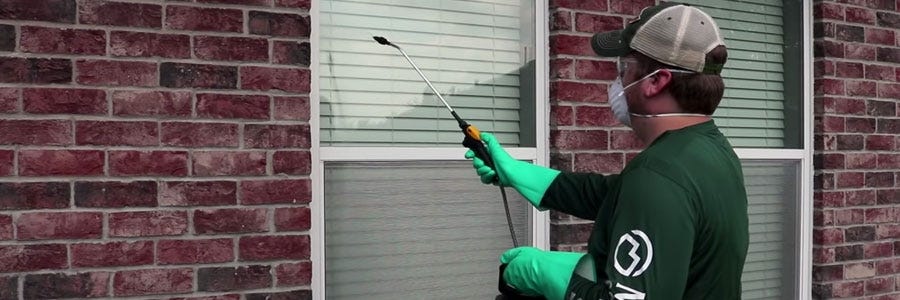
Microencapsulated pesticides have several advantages over conventional methods of liquid pesticide applications. For one, highly toxic chemicals can be mixed and handled safely because the plastic polymer coatings help protect the applicator from pesticide exposure.
Much like wettable powders, microencapsulated insecticides perform well on both porous and nonporous surfaces because insects readily “pick up” capsules from treated surfaces. For instance, capsules adhere to the spines of an insect's leg, enhancing the insect's control.
The delayed release of active ingredients prolongs effectiveness, resulting in fewer and less precisely timed applications.
Other benefits include Reduced volatility, which means less is lost from the application site, allowing for greater effectiveness. There is also reduced odor and less likelihood of staining or otherwise damaging treated surfaces. Microencapsulated products also often reduce injury to plants due to phytotoxicity.
Microencapsulated Pesticide Drawbacks
A few disadvantages of using microencapsulated insecticides include the need for the formulation to be constantly agitated in the spray tank (depending on the coating's properties).
Microencapsulated pesticides also have the potential to leave a visible residue when applied. They can also clog sprayer screens and nozzle tips.
Microencapsulated pesticides can be hazardous to bees. If the microcap particle does not break down quickly, a bee may mistakenly take it back to the hive, where the pesticide may be released and poison the colony. Some soil-applied microencapsulated products may leach into the soil and surrounding groundwater.
Our Recommendations
Cyzmic CS - Cyzmic CS (comparable to Demand CS) is an odorless micro-encapsulated insecticide with lambda-cyhalothrin that controls many pests around homes and buildings, including crazy ants and mosquitoes. It uses "cap-vantage" technology to make it safer to mix and apply. It is sometimes spelled Cysmic CS Insecticide.
Optimate CS - Optimate CS is a microcap insecticide with the active ingredient Gamma-Cyhalothrin, a powerful insect-killing chemical. Optimate CS has a broad label and can treat various pests in various locations. Its time-controlled formula gives this a long residual.
Tools Needed
To use Microencapsulated insecticides, dilute and mix the product in a handpump sprayer. It is also wise to put on the necessary PPE (gloves, protective eyewear, and a safety mask) before mixing and applying.
User Guide

Step 1: Check the Label
Read the label on the microencapsulated pesticide to determine the proper usage and rates. This will also give you helpful safety information and application tips that could be useful during the application process.
Step 2: Mix the Product
Determine how much product you will need by first measuring the square footage of the treatment area. To do this, you will need to measure the treatment areas' length and width in feet, then multiply them together (length x width = square footage). The label will tell you the rate of product to use per 1,000 sq. ft.
Add the required amount of CS concentrate to a hand pump sprayer filled with half a gallon of water. Agitate the sprayer, then add the remaining half-gallon of water and agitate again to ensure the products are properly mixed.
Step 3: Apply to the Target Area
For indoor applications, spray the solution in cracks and crevices, on door frames, window frames, baseboards, around pipes, and under cabinets and appliances. For outdoor applications, spray the solution 3 feet up the side of the structure and 3 feet out onto the ground to create a barrier for crawling pests.
Key Takeaways
- Microencapsulated pesticides are formulations in which the active ingredient is covered by a protective coating. They are popular for their long-term residual effect and quick knockdown.
- The long residual makes microcap products a solid choice when setting up a pesticide barrier around the perimeter of your home or building.
- Depending on the properties of the microcap coating, it may be necessary to constantly agitate the solution in the spray tank while applying it.






